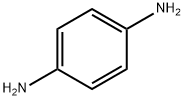106-50-3

Product Name:
p-Phenylenediamine
Formula:
C6H8N2
Synonyms:
1,4-Benzenediamine;1,4-Diaminobenzene;1,4-Phenylenediamine;4-Aminoaniline
Inquiry
CHEMICAL AND PHYSICAL PROPERTIES
| Physical Description | P-phenylenediamine appears as a white to purple crystalline solid (melting point 234 F) that turns purple to black in air. Flash point 309 F. Toxic by skin absorption, inhalation or ingestion. Used for production of aramid fiber, antioxidants, as a laboratory reagent, in photographic developing, and as a dye for hair and furs. |
|---|---|
| Color/Form | WHITE TO SLIGHTLY RED CRYSTALS |
| Boiling Point | 513 °F at 760 mmHg (NTP, 1992) |
| Melting Point | 284 °F (NTP, 1992) |
| Flash Point | 311 °F (NTP, 1992) |
| Solubility | 4 % at 75 °F (NIOSH, 2023) |
| Density | Greater than 1 (water= 1) |
| Vapor Density | 3.72 (NTP, 1992) - Heavier than air; will sink (Relative to Air) |
| Vapor Pressure | less than 1 mmHg (NIOSH, 2023) |
| LogP | log Kow= -0.25 |
| Stability/Shelf Life | ON STANDING IN AIR, OXIDIZES TO PURPLE AND BLACK /COLOR/. |
| Autoignition Temperature | 400 °C |
| Decomposition | Toxic gases and vapors (such as oxides of nitrogen and carbon monoxide) may be released in a fire involving p-phenylenediamine. |
| Ionization Potential | 6.89 eV |
| Dissociation Constants | The pKa value of the conjugate acid is 6.2 |
| Kovats Retention Index | 212.86 |
| Chemical Classes | Nitrogen Compounds -> Amines, Aromatic |
SAFETY INFORMATION
| Signal word | Danger |
|---|---|
| Pictogram(s) |
 Skull and Crossbones Acute Toxicity GHS06  Health Hazard GHS08  Environment GHS09 |
| GHS Hazard Statements |
H317:Sensitisation, Skin H319:Serious eye damage/eye irritation H370:Specific target organ toxicity, single exposure H410:Hazardous to the aquatic environment, long-term hazard |
| Precautionary Statement Codes |
P273:Avoid release to the environment. P280:Wear protective gloves/protective clothing/eye protection/face protection. P301+P310:IF SWALLOWED: Immediately call a POISON CENTER or doctor/physician. P305+P351+P338:IF IN EYES: Rinse cautiously with water for several minutes. Remove contact lenses, if present and easy to do. Continuerinsing. |
COMPUTED DESCRIPTORS
| Molecular Weight | 108.14 g/mol |
|---|---|
| XLogP3 | -0.3 |
| Hydrogen Bond Donor Count | 2 |
| Hydrogen Bond Acceptor Count | 2 |
| Rotatable Bond Count | 0 |
| Exact Mass | 108.068748264 g/mol |
| Monoisotopic Mass | 108.068748264 g/mol |
| Topological Polar Surface Area | 52 Ų |
| Heavy Atom Count | 8 |
| Formal Charge | 0 |
| Complexity | 54.9 |
| Isotope Atom Count | 0 |
| Defined Atom Stereocenter Count | 0 |
| Undefined Atom Stereocenter Count | 0 |
| Defined Bond Stereocenter Count | 0 |
| Undefined Bond Stereocenter Count | 0 |
| Covalently-Bonded Unit Count | 1 |
| Compound Is Canonicalized | Yes |
PRODUCT INTRODUCTION
description
P-phenylenediamine appears as a white to purple crystalline solid (melting point 234 F) that turns purple to black in air. Flash point 309 F. Toxic by skin absorption, inhalation or ingestion. Used for production of aramid fiber, antioxidants, as a laboratory reagent, in photographic developing, and as a dye for hair and furs.
